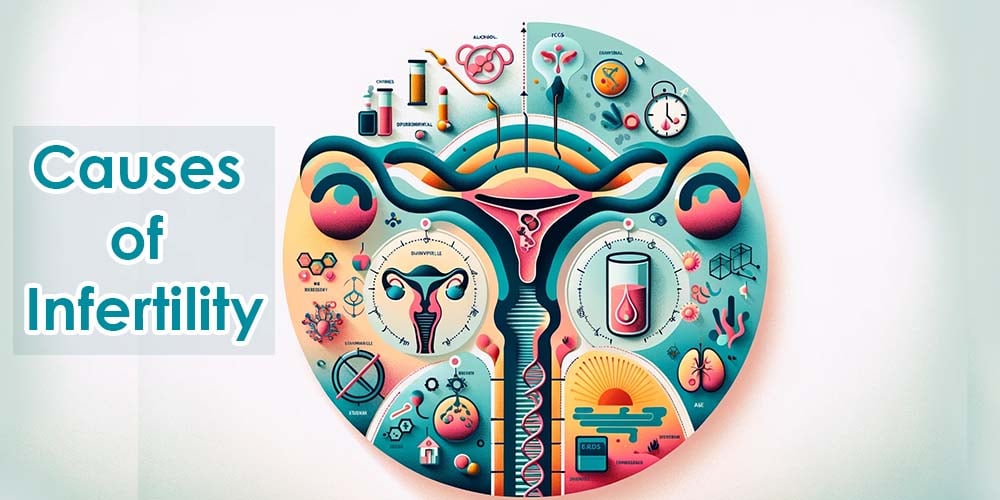
Age plays a significant role in fertility, particularly for women. Women in their 20s and early 30s typically have the highest chances of conceiving. However, as they reach their mid-30s, fertility begins to decline more rapidly, and by age 40, the chances of natural conception significantly decrease each month. For men, the decline in fertility due to age is more gradual, but it can become noticeable by the late 40s and 50s. The length of time a couple has been trying to conceive also impacts the classification of infertility. For couples where the female partner is under 35, infertility is usually defined as the inability to conceive after one year of regular, unprotected intercourse. However, for women over 35, this period is shortened to six months, reflecting the age-related decline in fertility.
While discussions about infertility often focus on couples who have not yet had a child, another category called secondary infertility also exists. This refers to couples who have previously conceived but are now facing difficulties in having another child. Secondary infertility accounts for a significant portion of infertility cases, and its prevalence is increasing in many parts of the world.
Therefore, the prevalence of infertility is a complex issue shaped by various biological, societal, and environmental factors. While global averages offer a general overview, understanding the nuances and regional variations is essential for a comprehensive understanding of infertility's scale and impact worldwide.
In this section, we will explore various causes of female infertility that affect the ability to conceive. Female infertility can result from a range of issues, from hormonal imbalances to physical abnormalities in the reproductive organs. The following subsections will delve into specific factors that can impair a woman's fertility, starting with ovulatory disorders, where disruptions in the release of eggs play a significant role. Additionally, we will discuss other contributing factors such as tubal blockages, endometriosis, and uterine conditions, all of which can hinder the natural path to pregnancy. By understanding these causes, we can better address the challenges faced by women struggling with infertility.
Ovulation is a crucial step in conception, where an egg is released from the ovary. Any disruption in this process can lead to ovulatory disorders. The most common of these is Polycystic Ovary Syndrome (PCOS). Women with PCOS produce higher-than-normal levels of male hormones, which can cause irregular menstrual cycles and prevent eggs from maturing. Another disorder is premature ovarian insufficiency, a condition in which the ovaries lose their function before the age of 40. This can be triggered by factors such as genetics, chemotherapy, or autoimmune processes. Hypothalamic dysfunction occurs when there is an imbalance in the brain hormones that regulate ovulation. Stress, extreme body weight (either too low or too high), and significant weight fluctuations can all disrupt this hormonal balance.
The fallopian tubes are pathways through which the egg travels from the ovaries to the uterus. Any damage or blockage in these tubes can prevent sperm from reaching the egg or hinder the fertilized egg from reaching the uterus. Common causes of tubal issues include pelvic inflammatory disease (often caused by untreated sexually transmitted infections such as chlamydia), previous surgeries in the abdomen or pelvis, and conditions like endometriosis.
Endometriosis is a condition in which tissue similar to the uterine lining grows outside the uterus. This abnormal growth can block the fallopian tubes or interfere with implantation. It can also affect the uterine lining, preventing proper implantation of a fertilized egg. The exact cause of endometriosis remains unclear, but it is believed to be linked to factors such as menstrual flow issues, immune system responses, and hormonal imbalances.
The uterus, or womb, is where a baby develops during pregnancy. Conditions such as fibroids (benign tumors), polyps, or other abnormalities can interfere with the implantation of a fertilized egg. Additionally, some women may be born with uterine structural anomalies, which can cause difficulties in maintaining a pregnancy.
The cervix is the lower part of the uterus that connects to the vagina. Abnormalities in this area can include cervical stenosis, a condition where the cervix becomes narrowed, or an inability of the cervix to produce the type of mucus that facilitates sperm movement. Additionally, procedures like cone biopsies can lead to cervical shortening, which may result in an "incompetent cervix"—a condition where the cervix opens prematurely during pregnancy, potentially causing a miscarriage.
Also referred to as premature ovarian insufficiency, this condition is marked by the loss of normal ovarian function before the age of 40. While the exact cause is often unclear, contributing factors may include genetics, chemotherapy, or radiation therapy. Women with this condition may experience irregular or occasional periods for years, though some may show no symptoms at all.
Pelvic adhesions are bands of scar tissue that form between internal organs, often as a result of pelvic infections, appendicitis, or abdominal and pelvic surgeries. These adhesions can disrupt the normal function of the ovaries and fallopian tubes, potentially leading to fertility challenges.
Conditions such as diabetes and untreated celiac disease can affect a woman's fertility. Poorly controlled diabetes may cause menstrual irregularities, while celiac disease can lead to malnutrition, which can disrupt menstrual cycles.
Hormonal balance is crucial for every stage of the reproductive process. Disorders such as thyroid dysfunction, elevated prolactin levels, or adrenal diseases can disrupt this delicate equilibrium, affecting ovulation, conception, and pregnancy.
Smoking accelerates the loss of eggs and may hasten the onset of menopause. Excessive alcohol consumption can contribute to ovulation disorders. Weight extremes—whether being significantly overweight or underweight—can disrupt menstrual cycles. Additionally, excessive physical or emotional stress can lead to amenorrhea, the absence of menstrual periods.
In this section, we will explore the various causes of male infertility, which can stem from a wide range of physical, hormonal, genetic, and environmental factors. Male infertility often goes unnoticed until couples face challenges in conceiving, making it essential to understand the underlying reasons. From varicoceles and hormonal imbalances to structural abnormalities and lifestyle choices, we will delve into the key factors that can affect sperm production, quality, and function. By identifying these causes, we can better address the complexities of male infertility and guide individuals toward appropriate treatments.
A varicocele is a swelling of the veins that drain the testicle. This condition can impair the testicle's ability to cool effectively, which is crucial for healthy sperm production. As a result, varicoceles may lead to a reduced sperm count and decreased sperm motility. While the exact mechanism by which varicoceles cause infertility is not fully understood, it is believed to be related to abnormal regulation of testicular temperature.
Ejaculation disorders can occur in various forms. Premature ejaculation happens when ejaculation occurs too quickly. Retrograde ejaculation occurs when semen flows into the bladder during orgasm instead of exiting through the tip of the penis. These conditions can result from certain surgeries, medications, or underlying health issues.
Cancers and nonmalignant tumors can directly impact the male reproductive organs. Treatments such as surgery, chemotherapy, and radiation, which are often necessary to address these tumors, can also disrupt sperm production, potentially leading to infertility.
The hormones produced by the pituitary gland and hypothalamus play a vital role in sperm production. Abnormalities in these hormonal systems or other related organ systems can contribute to infertility. Common conditions affecting hormonal balance include pituitary tumors, congenital deficiencies of LH and FSH (hormones responsible for stimulating the testicles), and the use of certain medications or drugs.
Genetic disorders, such as Klinefelter's syndrome, can result in abnormal development of the male reproductive organs. Other genetic conditions linked to infertility include cystic fibrosis, Kallmann's syndrome, and Kartagener's syndrome.
Certain medications can negatively impact sperm production and function. These include testosterone replacement therapy, chemotherapy, anabolic steroids, and specific antifungal or antibiotic medications.
These structural abnormalities can either be present from birth or develop later in life due to illnesses, injuries, or surgeries. Examples include blockages in the testicles, sperm-carrying tubes, or issues affecting the epididymis, vas deferens, or urethra.
Infections can disrupt sperm production or lead to scarring that blocks sperm passage. Examples include inflammation of the epididymis (epididymitis) or testicles (orchitis), as well as certain sexually transmitted infections (STIs) like gonorrhea or HIV.
Overexposure to environmental factors can negatively affect sperm production and function. Examples include industrial chemicals, heavy metals, radiation, and X-rays. Prolonged exposure to heat, such as in saunas or hot tubs, can also raise core body temperature, potentially impairing sperm production.
Illicit drug use can reduce both the number and quality of sperm. Alcohol consumption may lower testosterone levels, contribute to erectile dysfunction, and decrease sperm production. Tobacco smoking can also negatively affect sperm count. Emotional stress can disrupt the hormonal balance required for sperm production, while obesity can lead to hormonal changes that impair male fertility. In both men and women, individual factors vary, making it essential to consult a specialist for a comprehensive evaluation of fertility status.
Are you facing challenges in starting a family? Click on the banner now to connect with our expert consultants on WhatsApp and receive a free consultation. Let us help you take the next step toward your dream!
Infertility is a multifaceted issue that affects millions of couples worldwide, with causes varying from biological and hormonal factors to environmental and lifestyle influences. Understanding the underlying reasons for infertility, whether in men or women, is the first step toward addressing the challenges it presents. This article has explored the major causes of infertility, highlighting the importance of seeking timely medical advice and tailored treatments.
If you or someone you know is facing difficulties in starting or expanding a family, remember that you are not alone. With advancements in medical science and access to expert care, many couples overcome these obstacles successfully. Reach out to our experienced consultants today and take the first step toward making your dream of parenthood a reality.

Comments & Questions